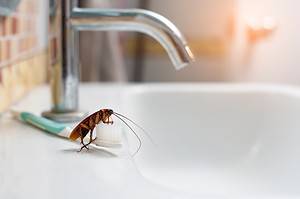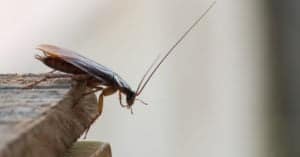Cockroaches are one of the most ancient and successful groups of insects on Earth, having evolved from primitive ancestors more than 280 million years ago. They are incredibly adaptable creatures living in a wide range of environments, from tropical rainforests to deserts. There are many different cockroach species, but the two most common types are the American (Periplaneta americana) and the German (Blattella germanica). Both of these species can be found in homes and businesses worldwide.
Cockroaches are often considered pests, but they have some beneficial qualities too. For example, they help to decompose dead organic matter, which helps to recycle nutrients back into the environment. Some cockroach species also provide food for other animals, such as lizards, frogs, and birds.
One interesting fact about cockroaches is that some species can grow quite large! In fact, some of these cockroach species are known to grow up to 3.5 inches or more! Like other cockroaches, these massive insects are essential to their ecosystems, helping break down dead leaves and other organic matter. Cockroaches may not be everyone’s favorite insect, but there’s no denying that they play a crucial role in our world. Today, we will look at 5 of the world’s largest cockroaches.
Megaloblatta Longipennis (M. longipennis)
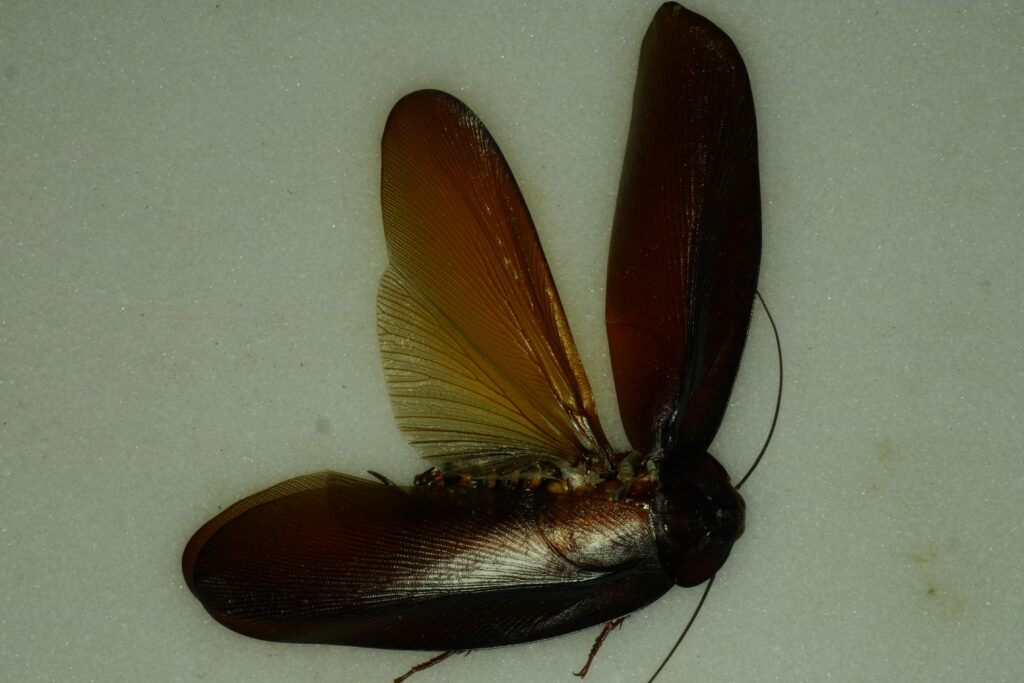
This cockroach is native to Central and
South America
but can also be found in other warmer climates worldwide.
©4,592 × 3,064 pixels, file size: 6.43 MB, MIME type: image/jpeg – License
Megaloblatta longipennis is a giant cockroach that can grow up to 3 and a half inches in length and has a wingspan of 8 inches. It is dark brown in color and has a flat, oval-shaped body. This cockroach is native to Central and South America but can also be found in other warmer climates worldwide.
Megaloblatta longipennis is nocturnal and prefers to live in damp, dark places such as under leaves or logs. These cockroaches are not typically found inside homes or other buildings. Unlike your usual household cockroaches that feed on rubbish, megaloblatta longipennis feeds on decaying plant matter and other organic material.
Male megaloblatta longipennis will court a female, and if she is receptive, they will mate for nearly two hours. The female will then lay her eggs (approximately 16-50 at a time) in a protected location, such as under a log or leaf litter.
When these eggs hatch, baby cockroaches are called nymphs. Nymphs are immature insects that will eventually grow into an adult. Cockroach nymphs look very similar to adults, but they’re smaller and don’t have fully developed wings. There are several reasons why cockroach babies are called nymphs, but it’s mainly a reference to their small size. Nymphs are also known for their rapid development – they can mature from an egg to an adult in just a few months. This rapid growth is another reason why they’re called nymphs. These cockroach nymphs hatch from the eggs after about two months and molt approximately seven times before reaching adulthood. Adult megaloblatta longipennis can live up to 10 years of age, although they may live longer when kept in captivity.
Giant Burrowing Cockroach (Macropanesthia rhinoceros)
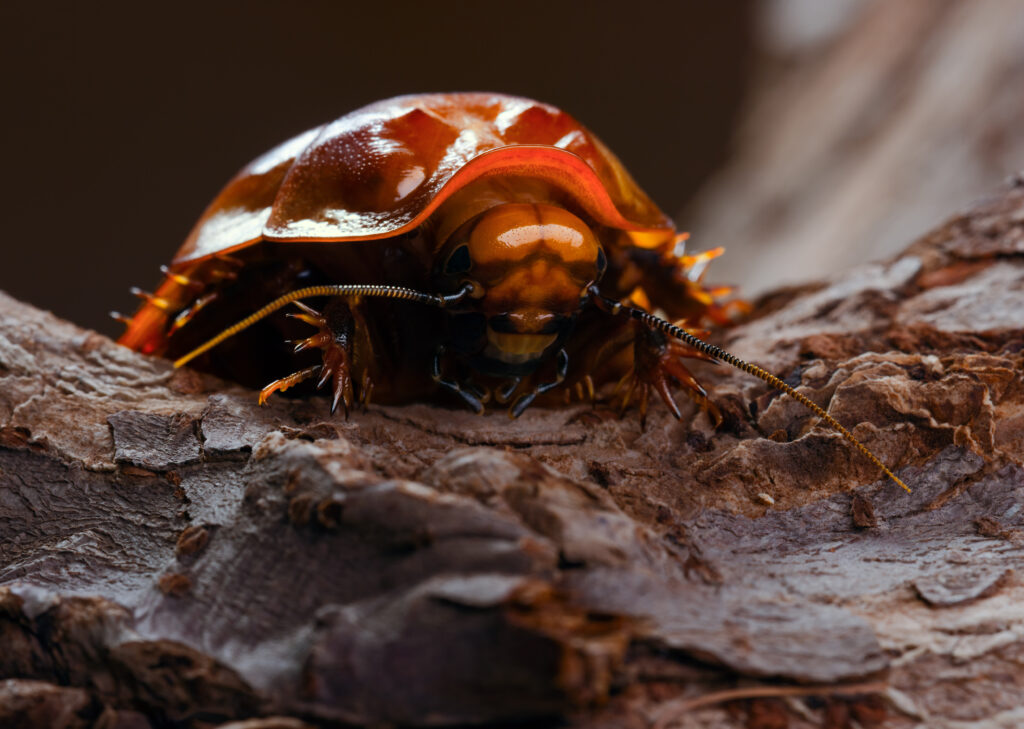
This cockroach is considered the heaviest cockroach species in the world, weighing up to 1.23 ounces or 35 grams.
©skydie/Shutterstock.com
The giant burrowing cockroach, scientifically known as macropanesthia rhinoceros, is a large, nocturnal cockroach native to Australia. It is the second biggest cockroach in the world, with adult giant burrowing cockraoches reaching up to 3.1 inches in length. This cockroach is considered the heaviest cockroach species in the world, weighing up to 1.23 ounces or 35 grams. In terms of color, the giant burrowing cockroach is dark brown or black, and it has a glossy exoskeleton.
Habitat
The giant burrowing cockroach is a burrowing species that spends most of its time underground in self-made tunnels. You may be wondering why the giant burrowing cockroach builds burrows. Burrows provide these creatures with shelter from extreme weather conditions and predators and help regulate the temperature and humidity levels around their bodies. By digging deep into the ground, cockroaches can create a microclimate that suits their needs perfectly – one that is cool and moist during hot summer days and warm and dry during cold winter nights. These tunnels can extend up to 3.5 feet or 1 meter in length and are used for shelter and breeding purposes.
Diet
The giant burrowing cockroach is also known to climb trees and enter homes for food. The diet of the giant burrowing cockroach consists mainly of decaying organic matter, such as leaves and dead insects. However, this cockroach will also eat live prey if given the opportunity.
Reproduction
Mating occurs during the summer months, and females will lay their eggs in small holes that they excavate in the soil. Once hatched, nymphs resemble miniature versions of adults and go through several molts before reaching maturity. Adults can live for up to 10 years in captivity.
Giant burrowing cockroaches are interesting creatures that play an essential role in their ecosystem by helping to recycle nutrients back into the soil.
Madagascar Hissing Cockroach (Gromphadorhina portentosa)
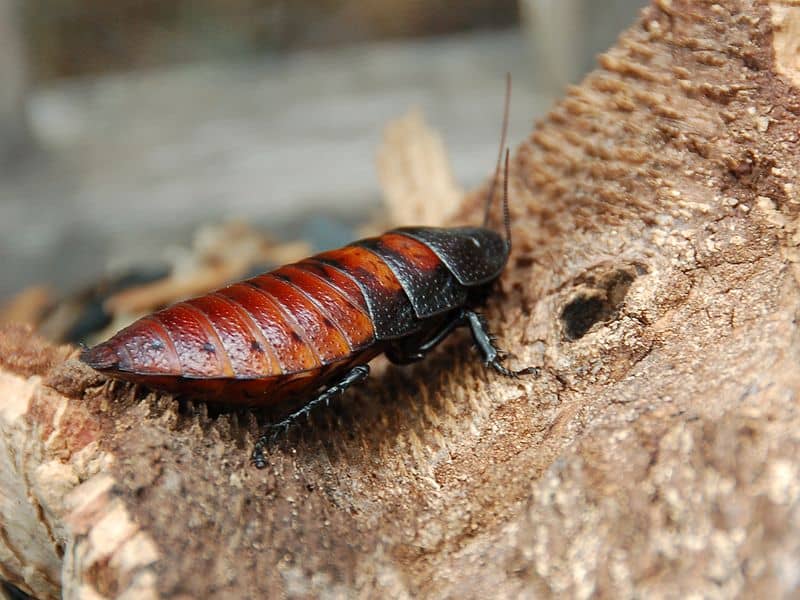
Madagascar hissing cockroaches are amazing creatures with a variety of unusual behaviors.
©Almabes – Public Domain
As the name suggests, this fascinating creature is native to Madagascar and is one of the largest species of cockroach in the world. They can grow up to 3 inches in length and are easily recognizable by their dark brown coloration and unique hissing sound.
Behavior
Madagascar hissing cockroaches are amazing creatures with a variety of unusual behaviors. For example, they are known to be very social insects, living in large colonies of up to several thousand individuals. And most notably, they can also produce a loud hissing noise by exhaling air through tiny holes in their abdomens.
There are several reasons why the Madagascar hissing cockroach hisses. One reason is to communicate with other roaches. The hissing sound is used to warn other bugs of danger or to indicate that they are in another roach’s territory. Additionally, male roaches use their hiss to attract mates. Another reason why the Madagascar hissing cockroach hisses is to intimidate predators. The loud, sudden noise can startle predators and cause them to retreat from the roach. This can also help ward off smaller insects that might try to eat them.
Habitat
The natural habitat of Madagascar hissing cockroaches is tropical forests, where they live among the leaf litter on the forest floor. These environments provide them with plenty of food and shelter from predators. In captivity, however, they can thrive in various climates, environments, and enclosures.
Diet
Madagascar hissing cockroaches are omnivorous creatures that will eat pretty much anything that is organic matter. Their diet consists primarily of decaying leaves and other plant matter in the wild. In captivity, these cockroaches can be fed various foods, including vegetables, fruits, meat scraps, and even dog or cat food.
Reproduction
Mating season for Madagascar hissing cockroaches typically occurs during the rainy season (from November to April). During this time, males will compete with each other for mates by engaging in wrestling matches. The victor of these matches will then mate with any available females. After mating, the female will lay a batch of eggs which she will carry around on her back until they hatch into nymphs (baby roaches). Larvae go through several molts (shedding their exoskeletons) before reaching adulthood at around 6-12 months old. Madagascar hissing cockroaches can live up to 5 years of age.
Death’s Head Cockroach (Blaberus craniifer)
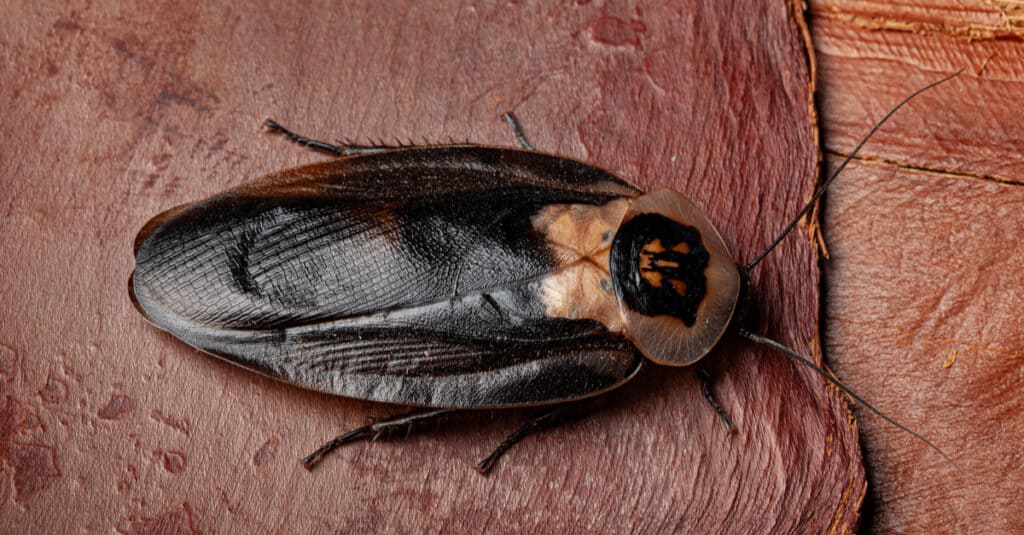
Death’s head cockroach will stand their ground and even hiss when threatened.
©K Hanley CHDPhoto/Shutterstock.com
The death’s head cockroach, or blaberus craniifer, is named so because of the distinctive marking on its back, which resembles a human skull. These markings are usually black or dark brown against a light brown or tan body. They are also enormous winged cockroaches, with adults reaching lengths of up to an incredible 3 inches.
Habitat
Death’s head cockroaches are native to Africa but are in other parts of the world through trade and travel. They are typically in warm climates and prefer humid conditions. Light attracts them, which is why they are often in homes at night when the lights are on.
Behavior
One of the coolest things about the death’s head cockroaches is their behavior. Unlike other cockroaches, which flee when disturbed, death’s head cockroaches will stand their ground and even hiss when threatened. This aggressive behavior has led to them being used in some traditional African medicine practices to ward off evil spirits!
Diet
Another interesting fact about death’s head cockroaches is that they can survive for long periods without food or water. They can go without food for up to 6 months and without water for up to 2 weeks. This makes them very difficult to get rid of once they have infested an area or home.
All of this makes the death’s head cockroach an incredibly fascinating insect. In fact, many people choose to adopt one as a pet due to these reasons mentioned above.
Reproduction
When it comes to mating, female death’s head cockroaches will only mate once at a time. After mating, the female will produce an egg sac containing around 40 eggs which she will then carry around with her until they hatch (usually after 4-8 weeks). The baby roaches or nymphs will disperse into the environment.
American Cockroach (Periplaneta americana)
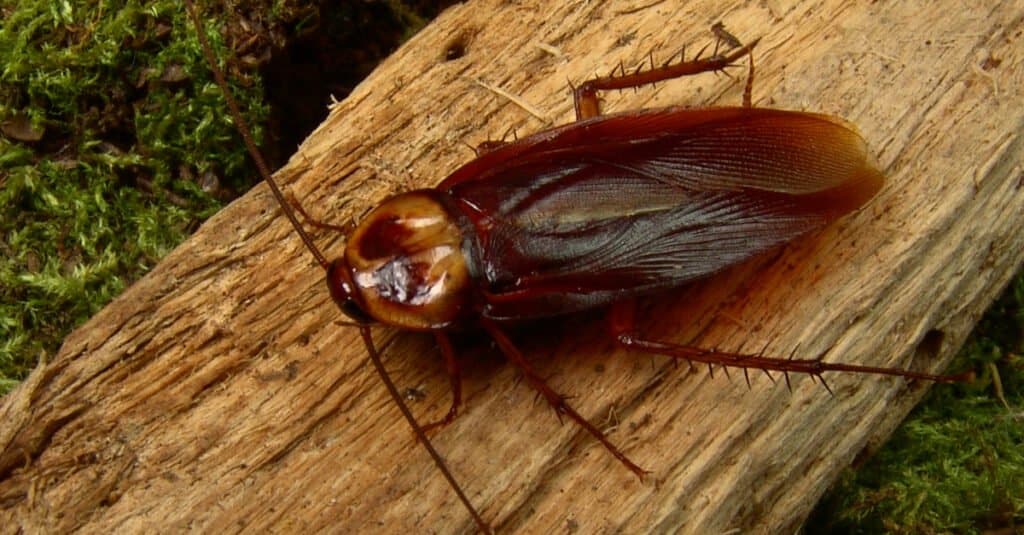
This cockroach is one of the most common species of cockroaches found worldwide.
©skifbook/Shutterstock.com
The American cockroach is also known as the Periplaneta americana. This cockroach is one of the most common species of cockroaches worldwide. Recognizable by its reddish-brown coloration and oval-shaped body. It typically measures between 1.4 and 2 inches in length, making it one of the larger common cockroach species.
The American cockroach is a very adaptable creature, and it has many habitats. These include homes, restaurants, food processing facilities, offices, hospitals, and anywhere else that provides suitable conditions for them to live in.
Habitat
There are a few reasons why this type of cockroach gravitates to indoor spaces. One reason is that they are seeking food and water. Cockroaches need food sources like crumbs or spills, and they also need a water source to drink from. All of these options are in many houses and businesses. Another reason cockroaches come indoors is for shelter. They prefer dark, humid places where they can hide away from predators and the elements.
One of the most interesting facts about American cockroaches is that they can run up to 3 miles per hour! They are also excellent climbers and can scale vertical surfaces with ease.
Diet
When it comes to diet, American cockroaches are omnivorous creatures that will eat just about anything available. This includes both plant and animal material. Some of their favorite foods include sweets, starches, meat scraps, rotting wood, and other insects!
Reproduction
Mating season for American cockroaches typically occurs during the warmer months of the year. After mating, female cockroaches will deposit their eggs in an egg case which will contain around 16 eggs on average. On average, female American cockroaches will have around 9-10 of these egg cases, resulting in around 144 to 160 eggs in total. Some can produce as many as 90 egg cases! Like many other cockroach species, baby cockroaches, also called nymphs, molt 13 times before finally reaching adulthood in around 6 to 12 months.
The photo featured at the top of this post is © kzww/Shutterstock.com
Thank you for reading! Have some feedback for us? Contact the AZ Animals editorial team.




